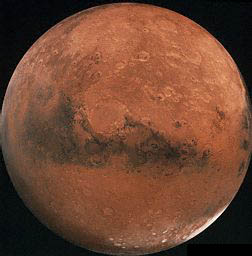

TERRA |
||
|

| Mars
Statistics
|
|
| Mars (kg) -- |
6.421e+23 |
| Mass
(Earth = 1) --
|
1.0745e-01 |
| Equatorial radius (km) -- |
3,397.2 |
| Equatorial
radius (Earth = 1) --
|
5.3264e-01 |
| Mean
density (gm/cm^3) --
|
3.94 |
| Mean
distance from the Sun (km) --
|
227,940,000 |
| Mean
distance from the Sun (Earth = 1) --
|
1.5237 |
| Rotational
period (hours) --
|
24.6229 |
| Rotational
period (days) --
|
1.025957 |
| Orbital
period (days) --
|
686.98 |
| Mean
orbital velocity (km/sec) --
|
24.13 |
| Orbital
eccentricity --
|
0.0934 |
| Tilt
of axis (degrees) --
|
25.19 |
| Geographic
Equivalents
|
|
| Chasma -- |
canyon |
| Fossa
--
|
narrow depression |
| Labyrinthus
--
|
valley complex |
| Mensa
--
|
mesa |
| Mons
--
|
mountain, volcano |
| Patera
--
|
shallow volcano |
| Planitia
--
|
basin, low plain |
| Terra
--
|
land, region |
| Tholus
--
|
domical volcano |
| Valles,
Vallis --
|
valleys, valley |
|
Vastitas
--
|
extensive plain |
| Temperature and Pressure The average recorded temperature on Mars is -63* C (-81* F) with a maximum temperature of 20* C (68* F) and a minimum of -140* C (-220* F). Barometric pressure varies at each landing site on a semiannual basis. Carbon dioxide, the major constituent of the atmosphere, freezes out to form an immense polar cap, alternately at each pole. The carbon dioxide forms a great cover of snow and then evaporates again with the coming of spring in each hemisphere. When the southern cap was largest, the mean daily pressure observed by Viking Lander 1 was as low as 6.8 millibars; at other times of the year it was as high as 9.0 millibars. The pressures at the Viking Lander 2 site were 7.3 and 10.8 millibars. In comparison, the average pressure of the Earth is 1000 millibars.
|
|
|
|
"We have just the right suite and space craft for you to handle this harsh terrain, Red." |
|
|
"I'm sure you do. So where is my new toy jet plane?" |
| Dekker:
|
"I'll show it to you later. first let me tell you about the myths and folk lore that has surrounded the planet Mars |
